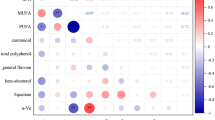Abstract
Germplasm evaluation of ex situ collections is needed to document collection characteristics, enhance utilization, and to determine collection needs. The objectives of this study were to (1) provide oil and meal evaluation information for a major portion of the United States Department of Agriculture (USDA) safflower (Carthamus tinctorius L.) collection, (2) compare ranges, variances and means between 203 core and 797 non-core accessions, and (3) determine if region of origin could be differentiated based on accession oil and meal characteristics. Means of the core and non-core accessions differed for % oil, palmitic acid, stearic acid, α-tocopherols, and phenolic glucosides (both bitter and cathartic) (P<0.05). Differences between linoleic acid, oleic acid and β-tocopherol means were not significant, and the variance between core and non-core accessions differed only for palmitic acid. Thus the core was not fully representative of the non-core accessions, but did capture a large fraction of the diversity in oil and meal factors present. Accessions from the Americas, China, South-West Asia, and South-Central Asia were differentiated using canonical discriminate analysis, but these regions overlapped to varying degrees with the E. European, Mediterranean, and E. African regions. Variation in % oil and fatty acids were generally more important than tocopherols and phenolic glucosides in differentiating accessions on a regional basis. The check cultivars Montola 2001 (high oleic) and Morlin (high linoleic) had oil and fatty acid content comparable to the maximums found in the collection. The ranges for tocopherols and phenolic glucosides among collection accessions, however, exceeded those of the cultivars, suggesting that collection accessions could be useful for genetic manipulation of these factors.
Similar content being viewed by others
References
Daun, J.K. & P.B. Mazur, 1983. Use of gas liquid chromatography for monitoring the fatty acid composition of Canadian rapeseed. J. Am. Oil Chem. Soc. 60: 1751–1754.
Fernández-Martínez, J., M. del Rio & A. de Haro, 1993. Survey of safflower (Carthamus tinctorius L.) germplasm for variants in fatty acid composition and other seed characters. Euphytica 69: 115–122.
Johnson, R.C., D.M. Stout & V.L Bradley, 1993. The U.S. Collection: A rich source of safflower germplasm, pp. 202–208. In: Li Dajue and Han Yuanzhou (Eds.), Proceedings Third International Safflower Conference — 18 June 1993, Beijing Botanical Garden, Institute of Botany, Chinese Academy of Sciences, Beijing, China.
Knowles, P.F., 1969. Modification of quantity and quality of saf-flower oil through plant breeding. J. Am. Oil Chem. Soc. 46: 130–132.
Knowles, P.F. & M.D. Miller, 1965. Safflower. California Agricultural Experiment Station Extension Service Circular 532. University of California.
Knowles, P.F. & A. Mutwakil, 1963. Inheritance of low iodine value of safflower from India. Economic Bot. 17: 139–145.
Li, Dajue & H.-H. Mündel, 1996. Safflower. Carthamus tinctorius L. Promoting the conservation and use of underutilized and neglected crops. 7. Institute of Plant Genetics and Crop Plant Research, Gatersleben, Germany/International Plant Genetic Resources Institute, Rome, Italy.
Liu, K., 1994. Preparation of fatty acid methyl esters for gaschromatographic analysis of lipids in biological materials. J. Am. Oil Chem. Soc. 71: 1179.
Lyon, C.K., M.R. Gumbmann, A.A Betschart, D.J. Robbins & R.M. Saunders, 1979. Removal of deleterious glucosides from safflower meal. J. Am. Oil Chem. Soc. 56: 560–564.
Manly, B.F.J., 1986. Multivariate statistical methods A PRIMER. First ed., Chapman & Hall, London.
SAS Institute. 1985. User's Guide: Statistics. 5th ed. SAS Institute, Cary, NC, 1985.
Steel, R.G.D. & J.H. Torrie, 1980. Principals and procedures of statistics. Second ed., McGraw-Hill, New York, NY.
Weiss, E.A., 1971. Castor sesame, and safflower. Barnes and Noble, Inc., New York, NY.
Williams, J.H., 1964. Registration of N-10 Safflower. Crop Sci. 4: 446.
Vavilov, N.I., 1997. Five Continents. International Plant Genetic Resources Institute, Rome, Italy.
Author information
Authors and Affiliations
Rights and permissions
About this article
Cite this article
Johnson, R., Bergman, J. & Flynn, C. Oil and meal characteristics of core and non-core safflower accessions from the USDA collection. Genetic Resources and Crop Evolution 46, 611–618 (1999). https://doi.org/10.1023/A:1008756600094
Issue Date:
DOI: https://doi.org/10.1023/A:1008756600094




